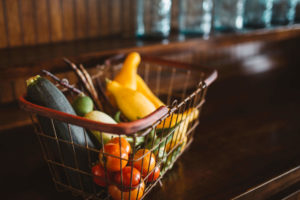
Specific diet plans are often prescribed for gastrointestinal symptoms like bloating or gastrointestinal diseases like short bowel syndrome, irritable bowel syndrome (IBS), inflammatory bowel disease (IBD) and motility disorders. These diets often involve manipulating the amount of fiber, FODMAPs and fat you eat. Use this guide when working with your doctor and nutritionist in order to prepare healthy meals made from mostly whole foods that fall within your specific diet plan.
Grains (low fat)
Lower fiber
Lower FODMAPs: white rice, cream of rice, white rice noodles, white rice pasta, polenta, grits, cornmeal, corn bread, corn tortillas, puffed rice, rice cakes, corn flakes and other unsweetened cereals
Higher FODMAPs: cream of wheat, farina, refined white flour noodles/pasta/pancakes/tortillas, white bread, pita bread, refined white flour muffins/rolls, plain refined flour crackers like saltines
Higher fiber
Lower FODMAPs: oats, buckwheat, maize, millet, quinoa, spelt, sorghum, brown or wild rice, polenta
Higher FODMAPs: whole wheat noodles/pasta/pancakes/tortillas, whole wheat bread/rolls/crackers, amaranth, barley, rye
Avoid
Pastries, donuts, cakes and other processed desserts, flavored cereals or pancakes with syrup
Vegetables (low fat)
Lower fiber
Lower FODMAPs: cooked vegetables including potatoes, plantains, squash, carrots, zucchini, turnip, tomatoes, green beans, ginger, parsnip, pumpkin. 12oz per day of fresh all-vegetable juices, seaweed
Higher FODMAPs: broccoli, cabbage, asparagus, Brussel sprouts, cauliflower, bell pepper, beets, eggplant, okra, fennel, garlic, leek, onion, shallots, mushrooms, sweet corn
Higher fiber
Raw vegetables or leafy greens: eat only in small amounts as tolerated
Avoid
Creamed, deep-fried or other highly processed vegetables
Fruits (low fat)
Lower fiber
Lower FODMAPs: peeled, cooked or unsweetened canned fruits with seeds removed including bananas, cantaloupe, grapefruit, grapes, kiwi, oranges, papaya, pineapple, strawberries
Higher FODMAPs: peeled, cooked or unsweetened canned fruits with seeds removed including apples, applesauce, apricots, pears, mango, watermelon, apricots, cherries, plums, peaches, blackberries, cherries, nectarines, prunes
Higher fiber
Raw peeled or unpeeled fruits: eat only in small amounts as tolerated
Avoid
Dried fruits, fruit canned in syrup, fruit juice or fruit drinks
Meats (low fiber, low FODMAP, low/high fat depending on type)
High quality, well-prepared chicken, turkey, fish, shellfish, eggs
Avoid
Raw meats, fried meats, processed meats
Dairy (low fiber, low/high fat depending on type)
Lower FODMAPs: lactose-free milk, oat/rice/soy milk (check additives), hard cheeses, brie, camembert, lactose-free yogurt
Higher FODMAPs: milk from cows, soymilk made with soybeans, goats or sheep, yogurt, soft unripened cheeses eg cottage cheese, cream cheese, ricotta, mascarpone
Avoid
Sweetened yogurts, flavored milks
Fats
Lower fiber
Lower FODMAPs: vegetable oils, olives, coconut (milk, cream, flesh), butter
Higher FODMAPs: avocado
Higher fiber
Lower FODMAPs: nuts and nut butters including brazil nuts, walnuts, pine nuts, almonds, chestnuts, coconut, hazelnuts, macademia nuts, peanuts, pecans, seeds (chia, sunflower, pumpkin, sesame)
Higher FODMAPs: nuts and nut butters including cashews, pistachios, tahini paste
Note: some patients may not tolerate nuts/seeds or nut/seed butters. Chew whole nuts/seeds well and begin with a trial of a single serving of nut/seed butter
Legumes (high fiber, low fat)
Lower FODMAPs: chickpeas, lentils snow peas
Higher FODMAPs: kidney beans, lima beans, mung beans, sugar snap peas, soy beans, split peas
Note: some patients (especially those without a colon) may do better with limiting legumes
Herbs, spices and more
Lower FODMAPs:A variety of herbs, spices and more including basil, cilantro, coriander, curry leaves, fenugreek, lemongrass, mint, oregano, parsley, rosemary, tarragon, thyme, all spice, pepper, cardamom, chili powder, cinnamon, cloves, cumin, curry powder, fennel seeds, mustard seeds, nutmeg, paprika, saffron, star anise, turmeric, asafetida powder (onion substitute), baking powder, baking soda, cacao powder, dark chocolate, stevia (sweetener), tamari, Bragg’s liquid aminos (soy sauce substitute), dark chocolate, strawberry jam, miso paste, maple syrup, mustard, tamarind paste, tomato sauce, apple cider vinegar, rice wine vinegar, balsamic vinegar, wasabi, hot sauce, tabasco sauce, nutritional yeast, garlic infused oil, maple syrup
Higher FODMAPs: agave, honey, mixed berry jam, soy sauce
Avoid
High fructose corn syrup, sugar-free sweets with polyols (usually ending in –ol or isomalt), artificial sweeteners including maltitol, mannitol, sorbitol, xylitol
Drinks
Lower FODMAPs: one glass of beer or wine, clear spirits like vodka, gin, whiskey, coffee (espresso, instant, regular/decaf), some teas (weak black or chai, weak fruit/herbal, green, peppermint, white), iced tea, oral rehydration solutions, soup broth, water (may need to limit depending on hydration needs)
Higher FODMAPs: more than one glass of beer/wine, coconut water, rum, sports drinks, some teas (strong black or chai, dandelion, fennel, chamomile, herbal, oolong)
Avoid
Alcohol when possible, more than 4oz coffee, tea or iced tea per day, flavored or sweetened coffees or teas, fruit juices or drinks, sodas, sugar free drinks, supplements like Boost, Ensure etc.
Oxalates
Oxalate-rich foods include tea, coffee, chocolate, nuts, soy products, green leafy vegetables, sweet potatoes, celery, berries, tangerines, rhubarb, rutabaga, wheat germ. Talk to your doctor and nutritionist to see if you need to avoid foods high in oxalates

